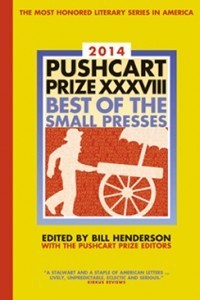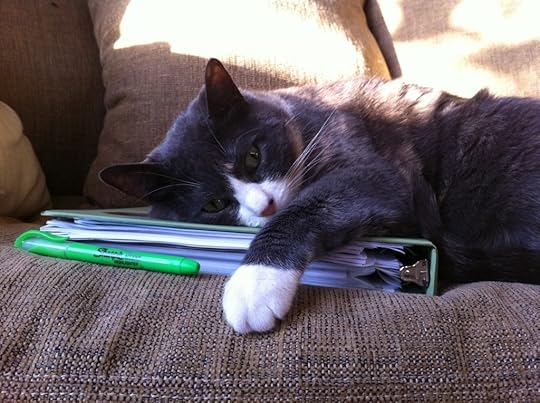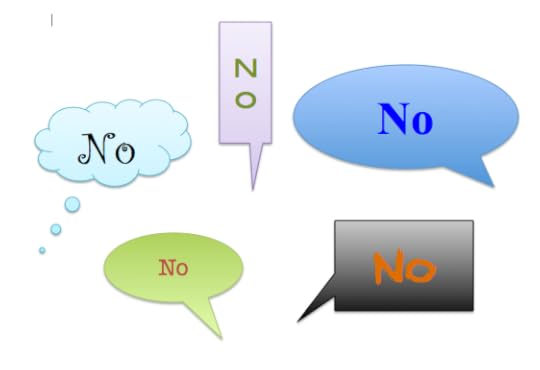Alida Winderhimer's Blog, page 4
January 2, 2014
The Necessity of Character Arc
Alida Winternheimer, author
In any story, the main character needs character arc; that is, he has to change.
This weekend I saw the new Coen Brothers film, Inside Llewyn Davis. I enjoyed the cinematic material, the visuals and soundtrack, for instance. I thought the characters were well-acted. I did appreciate the glimpse of a bygone musical era and I’ll probably buy the soundtrack. And yet, for me the story failed, because the Coen Brothers broke one of the most basic tenets of storytelling: there must be a character arc. At its most basic, this means the main character must somehow evolve. He must be different at the end of the story than he was at the beginning, even if the difference is subtle.
Look, Inside Llewyn Davis has good reviews, stars all over the ratings. I get that. I agree with the reviews if you watch it as a portrait of folk music at the inception of its heyday–Bob Dylan is newly appeared on the scene. The LA Times says, “It’s the music that moves ‘Inside Llewyn Davis.” Agreed. Journalist Randall Roberts explores the role of music in the story, admitting that Llewyn Davis is not a very likable character and the emotional movement in the film is created by the music.
“The exercise there,” Ethan Coen said, “is, what’s the most beautiful song he could sing at this point that would also be the most self-destructive?”
Whether you love Inside Llewyn Davis or not, ask yourself what you’d have if the music wasn’t there to carry the emotional movement of the story? In other words, if this was a story on the page, without the soundtrack, what would you have? O Brother Where Art Thou? would be a romp even without the soundtrack. Not so Inside Llewyn Davis.
Any time you set out to learn how to do something new, you will be confronted by a string of rules. And as the old adage goes, once you’ve mastered the rules, you are free to break them. Maybe that’s what the Coen Brothers were thinking when they wrote Inside Llewyn Davis, that they had mastered the rules of storytelling and now are free to bust them open. The catch is, breaking a rule only works if you make it work. Character arc is so deeply fundamental that I don’t think you can break this one, and Inside Llewyn Davis supports that claim.
Llewyn is a folk musician in 1961, so committed to his art that he’s afraid of being “careerist” and “square.” Maybe committed isn’t the right word, maybe delusional is better. Opportunities come his way and he blows them: he signs a contract as a freelance studio musician and doesn’t get royalties on a hit; a club owner is looking for the next Peter, Paul, and Mary, but Llewyn walks away instead of shaving his beard down to a goatee and joining a trio; he passes by the exit to Akron, Ohio after learning he has a child living there. The guy is such a loser he runs over his cat.
And yet, I liked him enough that I wanted him to evolve. No doubt I liked him because every time he sang I was moved. I watched him make one blunder after another and still wanted him to change for the better. Character evolution isn’t always for the better, but this guy was bottoming out the entire film, so I figured he had nowhere to go but up. In fact, there was so little character evolution—very none (with a wink to Pennie and Scott)—that the first scene in the movie was also the last. When I saw Llewyn get beat up in an alley the first time, I knew this guy was hitting bottom. There was nothing about the film to suggest we’d gone back in time and would be coming full circle, so I was surprised to see the scene play out a second time. The second time it made more sense because it was in context. But that was the sum total of the experience of seeing the alley scene repeated. I got it. Llewyn was hitting bottom. Still. Again. A character arc can be for better or for worse, but it can’t be a flat line. A flat character arc is an oxymoron, after all.
Maybe the Coen Brothers wanted to do a character study of how the descent looks. That’s fine. But then what? Doesn’t the audience deserve a pay-off? That is, the emotional satisfaction of having taken a journey with a character in whom they have invested that ends somewhere satisfactory. They seem to have a thing for The Odyssey. Suppose Ulysses never made it home. Men are eaten by the cyclops. Or turned into swine by the witch. Ships are broken on the sirens’ rocks. And the story ends with Ulysses (which is the name of one of the cats in the film) adrift, floating from one tragedy to another, while the suitors waste his fortune and Penelope dies chaste but paralyzed by her faith in her husband’s return. How would Homer’s audience have responded? I can tell you, Scott and I left the theater feeling the movie had been pointless. I could have instead watched a documentary on the early folk scene minus the depressing main character and that would have been satisfying.
What is the foundation of character arc? Agency.
I’ll say it again. Agency.
Your main character has to act. Has to make choices. Has to do something. Llewyn was drifting. Things kept happening to him. He was along for the ride and every time he had the opportunity to act, he didn’t. He drifted on by.
If you are thinking about flaunting the rules of storytelling, go ahead: play, experiment! Maybe you’ll make something amazing, but more likely you’ll have an experiment and nothing more. And if you are thinking about setting a character adrift, make sure it’s not your main character. Your main character needs 1) a goal, 2) obstacles, and 3) agency. But don’t take my word for it. Examine all the stories you love, then watch Inside Llewyn Davis and make up your own mind about the role of character arc in storytelling.
The post The Necessity of Character Arc appeared first on wordessential blog.
December 5, 2013
Pushcart Prize
Alida Winternheimer, author
What a week it’s been! I went away over Thanksgiving weekend for a quiet retreat with Scott–no wifi, no kids, no dog, no holiday. (Sorry Mom and Dad, but we needed the down time.) Despite unwinding, I had to check email on the phone once in a while to see if the dog sitter needed anything, right? No dog news, but I got an email from Ben Goodney, Editor at Storm Cellar literary journal saying that my story “Wild Animal” was nominated for a Pushcart Prize.
On Tuesday, I got an email from Sheila O’Connor, the Fiction Editor at Water~Stone Review saying that my story “The Herd” was also nominated for a Pushcart Prize.
No kidding.
I didn’t record my happy dances, so I’m going to show you Seva in a party hat, cause really, what’s more happy than that?
The post Pushcart Prize appeared first on wordessential blog.
October 27, 2013
Memory & Story: A Writing Exercise
Alida Winternheimer, author
This past week I taught a workshop on Memory and Story through the Hennepin County Library and St. Louis Park Senior Program. I announced right away that this was a workshop and we were going to learn by doing–and boy, did we! Seventeen writers, two days, and lots of writing. I participated in the exercises I assigned. When you’ve been working on a few long-term projects for a while, you forget to just practice and it was fun to cut loose and play with new material. The writers ranged from those interested in sharing their memories with their children and grandchildren to those who were working on their memoirs. We were all storytellers.
Not all of the writing was “good” as good goes (I can say that because one of my pieces shall never see light of day!), but it was all good writing, every single word. That is the beauty of freewriting. In freewriting, you let the mind roam and keep the hand moving. Simple. Easy. Surprising! I think I first learned—many years ago—about timed writing exercises in Natalie Goldberg’s Writing Down the Bones. If you aren’t familiar with that book, grab a copy. The short essays provide a glimpse of Natalie’s writing life with lots of inspiration, encouragement, and exercises.
I showed my fellow writers Lawrence Sutin’s Postcard Memoir. As memoir goes, the form is unique, engaging, beautiful. I wanted them to see that memoir does not have to plod along a timeline, ticking off life events with each added birthday candle. Sutin’s work is reflective, amusing, and honest. He pairs each short piece of writing with an antique postcard. After reading a couple of Sutin’s pieces, I passed out copies of some vintage postcards from my own collection, including some tattoo flash art from back when you could get inked for under $5, a riverboat scene, and Buffalo Bill Cody in his buckskin coat, among others.
In the exercise we did, each writer selects an image as a starting point, then freewrites for 15 minutes. The image might remind you of something. It might inspire a setting or character for some fiction. It might start you ruminating on some facet of life. The fun of this exercise is that you look at an image and start writing the first thing that comes into your mind. You keep writing wherever your thoughts and the words take you. Without a predetermined topic or destination, your writing is free to go anywhere and you just get out of the way and keep your hand moving. In fact, if you get stuck, you write “I am stuck. I am stuck. I am stuck….” until the next thought comes to mind.
I chose an image of an old farm wife sitting in front of a cast iron stove with a paring knife and bowl on her lap. She might be pitting cherries or trimming radishes—we weren’t sure. I chose it because my grandparents had a wood-burning stove in their home. I thought I was going to write about my grandmother and the antique iron trivets that used to hang on the brick wall behind the stove. My freewriting, however, led me in another direction. Take a peak if you like, it’s below. This is raw, unpolished writing that ends when the time runs out. This is freewriting. We don’t judge freewriting.
As for your writing, set a timer for 15 minutes. Get out your notebook and pick up your pencil. Ready? Set? Go!
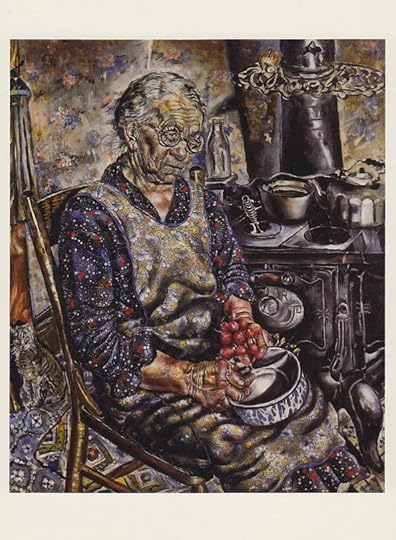
The Farm Wife
My freewriting:
My grandmother’s house, “the cottage,” we called it, sat on Lake Eunice in the Detroit Lakes area of Minnesota. It was really my grandparents’ house, of course, but I was so fond of Gramma and less so of Granpa, that I always thought of it as Gramma’s house—you know the way you do. Eventually this became accurate because she outlived Granpa by quite a few years. I was a freshman in college when Granpa died and a mother of a preschooler when Gramma died. If I’m honest, only one of those departures was difficult for me.
Granpa was a crotchety old cuss if ever there was one. He was tall and stoop-shouldered. He shuffled through life as though that bend in his neck made it impossible to take a regular step. He smoked Red Owl cherry tobacco in his pipe, which he kept on the cast iron wood-burning stove in the cottage. I brought it to him once, believing he’d misplaced it. I was expecting something like warmth in return, a “thanks, I was missing that,” or “how fortunate you are clever enough to return objects to their rightful owners.” Instead he said with the gruff voice of a smoker, “I know. Now put that back where you got it from.” I did as I had been told and left him to seek the softer company of the women in the house.
Granpa’s ears and nose never stopped growing, not even for a quick nap. I understand that is the way of these cartilaginous appendages, on all of us, not just him. Granpa’s features had become exaggerated to the point that I marveled at their size. Once, when my brother and I got into it and I was uncharacteristically mean, I called him “grandpa-zit-nose,” combining two horrors of adolescence in one insult. It was rather prescient of me, since my brother is five-and-a-half years older than me and I had not yet hit puberty. He winced, which is how I knew even then that I had both achieved my objective and been regrettably unkind.
The post Memory & Story: A Writing Exercise appeared first on wordessential blog.
October 23, 2013
Best Gift for a Writer
Alida Winternheimer, author
This weekend, my wonderful partner, Scott, and I celebrated our five-year anniversary. After I opened my present, I asked what had led him to the Oxford English Dictionary. He had done a search for the best gift for a writer, and what came up on all the top ten lists of best gifts for writers? The OED.
When I Googled “best gifts for writers,” Chuck Wendig’s Terribleminds blog was second on the page. (How’d he get so high in the search results, you know, above giant gift manufacturing and selling conglomerates?) I like his blog, so there I went. His list includes:
21. A WEIRD OLD GIGANTIC-ASS DICTIONARY
Chuck Wendig also recommends Neil Gaiman as a perfect gift for your writer friend. I can’t disagree.
Right below Terribleminds was, in fact, a gift store for writers. Thank goodness Scott didn’t shop there. Know what I don’t need? A typewriter key necklace. Please, people, stop destroying serviceable typewriters to make kitschy baubles out of the keys. I also don’t need a mug with Shakespearean insults. If you give me one, expect to be called a fustilarian yourself.
The Loft Literary Center suggested a subscription to the OED online–not quite the same, is it? They also recommended a t-shirt that says, “Careful, or you’ll end up in my novel.” You can do better than that.
I don’t know what lists Scott found, but he done good!
Have you seen the OED?

The OED
Now that is a dictionary! OK, Scott did not buy me a first edition set. We’d have to build a library just to house it.
I am now the proud owner of a 1971, two-volume, Compact Edition of the Oxford English Dictionary. How does one fit all the words in the English language as of 1971–and let’s face it, all the best words were around by 1971–into only two books? Photographically reproduce the pages at one-quarter of their original size.
That’s right. My dictionary has four pages on every page.

1971 Compact Edition OED
Which explains the first part of my gift. That afternoon Scott snuck out on a secret errand. I spent the afternoon guessing. He stepped out to buy a card. He was getting me a nice scarf like I asked for, and boy would he need some luck to find one the day of. He was picking up gourmet chocolates and wine…. He came home and went straight to the dark room. I heard the pssht! pssht! of compressed air and thought he was dusting a framed image. He had one of his photos framed and had to pick it up. Obviously.
My gift was not the shape or size of framed art. In fact, it was in three parts. The first part, which was oddly triangular, turned out to be a magnifier. I looked at it and said, “You went to Ax-Man and got me a magnifying glass.” He tried to deny it, but I was onto him by then.
I picked up part two of my gift and said, “You bought me a large book with very very small print and a magnifier.” Again he tried to deny it.
The funny thing is, I had no idea how accurate that statement was. I opened the OED and exclaimed, “Holy crap! That is smallest print I have ever seen.”
With my 5x magnifier I can just about make out the words. Seriously. I’m going to need a much bigger magnifier!
This post would not be complete without a word to the wise from the OED itself (randomly selected, of course):
Fankle: to tangle, entangle; to entrammel (a horse, etc.) with a rope; hence, to get fankled: fig. to lose the thread of a discourse.
The post Best Gift for a Writer appeared first on wordessential blog.
October 18, 2013
Writing Classes: Story & Memory, Time & Place
Alida Winternheimer, author
I’ll be teaching two writing classes in St. Louis Park, MN in the coming weeks.
Story and Memory is first at the St. Louis Park Library and the Lenox Community Center.
Here’s the workshop description:
Story and Memory: Are you full of interesting memories, but aren’t sure how to spin them into yarns? In this two-part workshop, we’ll work with our own memories and turn anecdotes into tales. Then we’ll ask, “Now what?” From diaries to a simple blog, it has never been easier (or cheaper!) to share your stories.
I’m also teaching a workshop on Time & Place on Saturday, November 2, from 1-4:00, also at the St. Louis Park Library. Call 612-543-6125 to register.
Here’s the workshop description:
Bringing Time & Place to Life in Your Fiction: Whether you are writing your memoir, a gritty mystery, an intergalactic fantasy or a literary masterpiece, you need to put your reader in the action with your characters, using details specific to the world you’re creating. We’ll discuss the writer’s process, look at examples, practice writing and share work. Writers of all abilities are welcome.
I’m filling these classes with great writing exercises, memory jump-starters, and everyone will have the opportunity to share what they write in class.
For example, how do you create that vital image that sticks with a reader? We’ll cover that in Time & Place!
The post Writing Classes: Story & Memory, Time & Place appeared first on wordessential blog.
October 14, 2013
Debuts
Alida Winternheimer, author
Saturday I went to the Rain Taxi Book Fair, where I was proud to be part of two debuts!
JoAnn Bren Guernsey’s chapbook, Tangled Strings, published by Red Bird Chapbooks made its first public appearance. I was editor and designer for the book. And my favorite photographer, Scott Stillman, shot the cover.
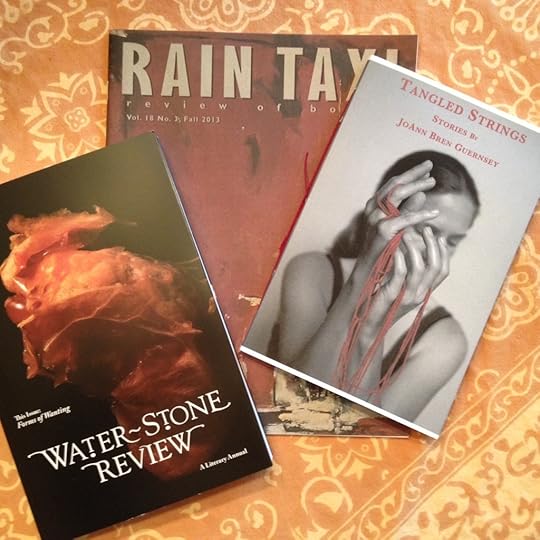
Great debuts at Rain Taxi!
Water~Stone Review, volume 16, also debuted at Rain Taxi. My story, “The Herd,” is published in this issue of Water~Stone. There is a reading to celebrate volume 16 on November 8th, 7:00 p.m., in Sundin Hall at Hamline University. I’ll be there to read from “The Herd.” Please join us!
The post Debuts appeared first on wordessential blog.
October 9, 2013
Method Writing
Alida Winternheimer, author
How far would you go to create a character? Have you ever pretended to be that character, speaking in his voice? Walking around the room the way he walks to get a feel for those motions before you try to put them into words? Journaling as that character to better understand how he sees the world? I think we writers do those things from time to time, especially when a character is being difficult. In the past, I’ve mostly used my mind to get into a character, trying to think like him. Sometimes I move my body to help me describe something I’ve already decided a character is doing. Lately, thanks to Seva*, I’ve been thinking about taking this further. I’ve been thinking about Method Acting, and its sisters, Method Training and Method Writing (yeah, I just made up those terms).
*I’m training a service dog, and you can read all about that here.

Seva at the creek.
Method Training
Seva will go to someone with a physical disability. As we get into more advanced skills, I have to ask more of her and do less myself. This means, instead of reaching out to take something from her, I have to wait until she puts it in my hand. To help with Seva’s training, I have to imagine I have a disability. Like method acting, I think of this as method training.
I’ll give some examples.
A lot of graduates (that’s what Helping Paws calls the people who receive the dogs) don’t have very good manual dexterity. It’s hard to grasp and hold objects in their hands. So, if I’m pretending I don’t have good manual dexterity, when Seva retrieves an object and doesn’t quite get it in my hands, I let it fall and ask her to retrieve it again. Right now, she is learning to hold something in her mouth without chewing or dropping it while I pretend I can’t quite get hold of it and touch her muzzle before finally taking the object.
Some graduates are partially paralyzed. If I drop my keys between my feet, I pretend my feet are paralyzed and let Seva figure out how to get the keys without any help from me.
Some graduates are ambulatory, but need support. When we train on a staircase, I tell Seva to “Step,” and she places her front paws up (or down) one step, then waits while I use her as a brace to bring myself up (or down) that step. I don’t really need her for support, but I put some weight on her so she knows what it feels like to be used as a brace.
We use wheelchairs at the training center so the dogs get used to walking beside them. One day, we put tennis balls behind our backs. We had to hold the balls in place, which meant we couldn’t lean forward to hold out a hand to our dogs. They had to get each item they retrieved in our hands, even if our knees or the chair’s wheels were in the way.
The dog packs have a belly strap that buckles. Sometimes, I sit in a chair and make her bring me her pack. Then I hold it out and Seva has to walk through the chest strap without any help (like making the opening wider). Then she has to rise onto my lap so the buckle is easier for me to reach. When she gets dressed this way, I’m teaching her to adapt to my needs, instead of doing it the same way every time and establishing a pattern of how much—or how little—she has to do to get dressed.
As I train Seva and work through many of the ways her help could be needed, I’m reminded how fortunate I am to be able to take my mobility for granted.

Longhand is more kinesthetic than typing.
Method Writing
Some things need to be experienced to be understood. Last week I was sitting outside a cafe across from Loring Park. A man and woman came down the sidewalk past the tables. They both had white canes tapping along before their feet. He was clearly sighted. She had a blindfold on. I noticed as she passed that this blindfold was serious. It had rubber edging to make sure it wouldn’t gap and there was no way for her to sneak a peak out the bottom and watch where she placed her feet. I don’t know if this woman is blind or sighted or something in-between. I only know that the man was teaching her how to get around with a cane.
I wanted to say, “Excuse me!” and ask them about their work. Why were they doing that? Was she learning how to use a cane so she could become a teacher or because she will need that cane herself? What was it like to have to get around without your vision? Was she scared of tripping? But I didn’t say anything. I watched them shamelessly as they passed and wondered to myself.
If I were to write a blind character, wouldn’t it be good to know what it feels like to get around without my sight?
Now, I don’t mean to boast, but I am great at research and I have a really big imagination. I’ve imagined all kinds of things without actually experiencing them. Still, as I’m training Seva by limiting my abilities, I’m learning things about what that’s like. Especially about all the movements and trivial activities that I take for granted throughout the day. And it has me thinking…
In this very cool video, a martial artist is photographed for David Dalglish’s Shadowdance books. The martial artist says that he went through the books and wrote out all the descriptions of the assassin’s fight moves. The moves he’s doing for the photo shoot are impressive, so I’m wondering if Dalglish is a martial artist himself? Has he experienced these moves in his body, or did he imagine them from his couch? I’m guessing that even if he’s not a martial artist, he’s athletic and is in touch with how his body feels in motion.
Getting the kinesthetic experience on the page is a skill that is enhanced by personal experience, whether it’s ninja moves, horseback riding, ballet, or piano playing. Can a good writer fake it? Probably. But I’m convinced bodily experience will add a dimension to the prose that the writer only discovers by Method Writing.
I’d like to hear what other writers do to get those physical descriptions on the page.
Now, if you’ll excuse me, it’s time for my kung fu class.
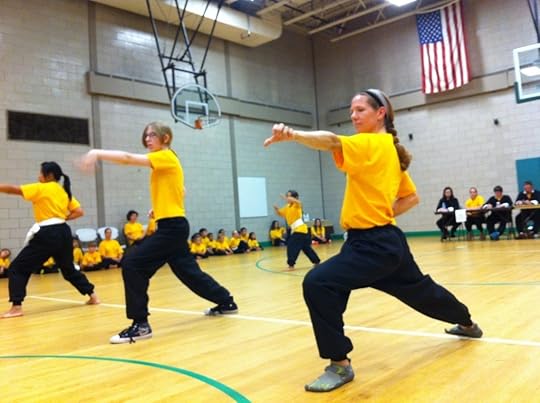
Kung Fu class
The post Method Writing appeared first on wordessential blog.
September 17, 2013
My Midwestern Gothic Author Profile
Alida Winternheimer, author
Midwestern Gothic runs profiles of its authors. You can get to know them along with reading their works.
My story, “Creatures,” is in issue 10, and here is my profile at midwestgothic.com.
Find out about Henry Humbug and who I’d have coffee with.
The post My Midwestern Gothic Author Profile appeared first on wordessential blog.
August 15, 2013
Saying No
Alida Winternheimer, author
Do you have a problem saying no? I sure do. I say yes to all kinds of things, often without thinking about whether that is the right thing for me. I say yes because I like the person asking, because I feel obligated, because I would feel guilty saying no, because I think it will be good for me….
Sound familiar?
Then I lament the fact that the things that go undone each day are things that really matter to me, the things I consider “my work.”
Sound familiar?
I came across a blog post about saying no the other day thanks to author/ entrepreneur/ speaker Joanna Penn. The blog addressed this issue of saying yes to our own creative and productive detriment by pointing out a number of highly creative and productive people who typically say no. The blog by Kevin Ashton is a quick and worthwhile read. Take a peek for yourself.
Here’s the gist of it: A professor asked creative people for an interview for a book he was writing.
The professor contacted 275 creative people. A third of them said “no.” Their reason was lack of time. A third said nothing. We can assume their reason for not even saying “no” was also lack of time and possibly lack of a secretary.
This week I had three appointments that were optional. They were with other writers, people whose friendship I value immensely. With two of them, I talked about the problem of time management, responsibilities, and getting my writing work done. It’s a problem many of us share, but it’s not outside of our control. Right after commiserating with my friends, I read this:
Time is the raw material of creation. Wipe away the magic and myth of creating and all that remains is work: the work of becoming expert through study and practice, the work of finding solutions to problems and problems with those solutions, the work of trial and error, the work of thinking and perfecting, the work of creating. Creating consumes. It is all day, every day. It knows neither weekends nor vacations. It is not when we feel like it. It is habit, compulsion, obsession, vocation. The common thread that links creators is how they spend their time.
Talking about writing is important. Having writer friends is important. But I realized, yet again, that I need to practice saying no. Even when it feels like I am depriving myself–of the excellent company of friends–or when I know I’ll feel a twinge of guilt–my kid’s on summer break and wants me to go to the movies. I know that “time is the raw material of creation,” so why do I keep saying yes? So many reasons, but very few of them are as important to me as my drive to create. I will continue to say yes when it matters, when I need it, when I have time to spare, just not as often as I have been.
I am going to be more judicious with yes. I am going to practice saying no. I invite you to do the same.
Hey, can you do me a favor?
Go on, say it!
The post Saying No appeared first on wordessential blog.
May 16, 2013
Creatures Will Be Published!
Alida Winternheimer, author
My short story “Creatures” will be published in the next issue of Midwestern Gothic!
I am especially excited for several reasons:
1. “Creatures” is part of the collection I’m working on. “The Herd,” which will be in this year’s Water~Stone Review, is the title story of said collection.
2. “Creatures” is Scott’s favorite story. Or maybe it’s in a tie with “Wild Animal,” which appeared in the spring Storm Cellar–wow, it’s a good year for Scott’s favorite stories.
3. This story is about as Midwestern and as gothic as it gets. There is a major creep factor at play. I think it’s appropriate that it found a home in Midwestern Gothic.
4. “The Herd” serves as an umbrella to all the other stories in the collection, and no two stories are as linked as these two.
5. Midwestern Gothic is a really cool journal! They are shining a light on this old bread basket of ours in the middle of America, and gosh darnit, it’s about time somebody did it!
Midwestern Gothic is a quarterly print literary journal out of Ann Arbor, Michigan, dedicated to featuring work about or inspired by the Midwest, by writers who live or have lived here. Midwestern Gothic aims to collect the very best in Midwestern fiction writing in a way that has never been done before, cataloging the oeuvre of an often-overlooked region of the United States ripe with its own mythologies and tall tales.
Don’t be fooled by our name. Gothic fiction is often defined as the inclusion of deeply flawed, often “grotesque” characters in realistic (and, oftentimes unpleasant) settings/situations. At Midwestern Gothic, we take to heart the realistic aspects of Gothic fiction. Not every piece needs to be dark or twisted or full of despair, but we are looking for real life, inspired by the region, good, bad, or ugly.
As mission statements go, that’s a good one, but heck, I’ll give these guys points just for putting “oeuvre” and “tall tales” in the same sentence. I also had the pleasure of meeting Jeff and Robert at AWP. Would I sound too Midwestern if I said it was “nice” to meet them? And did I mention they published a number of Scott’s photographs? (Scroll down until you see the Super 8 sign.)
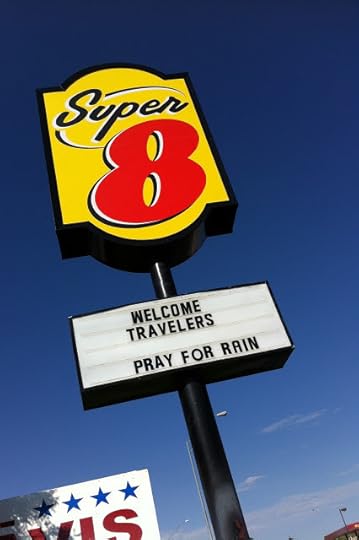
Pray For Rain
Now, if you’ll excuse me, I have to get back to celebrating.
The post Creatures Will Be Published! appeared first on wordessential blog.

